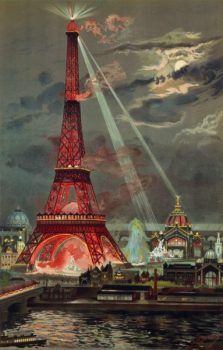Hollis Clayson at nonsite:
 When the Eiffel Tower—the daring centerpiece of the centenary celebration of the French Revolution, the 1889 Exposition Universelle—was new, it was widely disparaged for its impertinent mechanical appearance. The distinctive 300-meter iron structure still looms over western Paris from the Champ de Mars close to the Seine, but it is now admired, even adored. The history of the Tower thus contains a two-fold surprise: it was the odd World’s Fair edifice to survive, and, though once reviled, it is now loved. Not only has the old derrick-shaped monument become endearing, its thrusting gigantism, surprising shape, and unapologetically industrial materials, along with its attention-grabbing nocturnal lighting and mesmerizing daytime transparency, make it inescapable in many districts of the French capital city. And not only there: owing to its nonstop reproduction and circulation, its familiarity exceeds the spaces of Paris. On account of its global popularity, it is called an urban icon. According to leading image historians, the Tower is “a reference-point for urban signification,” “the iconic object of Paris,” and “the archetype for all urban icons to follow.” The parent of this outlook was literary critic Roland Barthes. In 1964, he argued influentially that the bases of the Tower’s clout are its widespread fame and its emptiness: it is both “a pure signifier” and “an utterly useless monument” meaning that wherever the Tower is known, it absorbs any claim whatsoever about its identity and significance.
When the Eiffel Tower—the daring centerpiece of the centenary celebration of the French Revolution, the 1889 Exposition Universelle—was new, it was widely disparaged for its impertinent mechanical appearance. The distinctive 300-meter iron structure still looms over western Paris from the Champ de Mars close to the Seine, but it is now admired, even adored. The history of the Tower thus contains a two-fold surprise: it was the odd World’s Fair edifice to survive, and, though once reviled, it is now loved. Not only has the old derrick-shaped monument become endearing, its thrusting gigantism, surprising shape, and unapologetically industrial materials, along with its attention-grabbing nocturnal lighting and mesmerizing daytime transparency, make it inescapable in many districts of the French capital city. And not only there: owing to its nonstop reproduction and circulation, its familiarity exceeds the spaces of Paris. On account of its global popularity, it is called an urban icon. According to leading image historians, the Tower is “a reference-point for urban signification,” “the iconic object of Paris,” and “the archetype for all urban icons to follow.” The parent of this outlook was literary critic Roland Barthes. In 1964, he argued influentially that the bases of the Tower’s clout are its widespread fame and its emptiness: it is both “a pure signifier” and “an utterly useless monument” meaning that wherever the Tower is known, it absorbs any claim whatsoever about its identity and significance.
more here.
